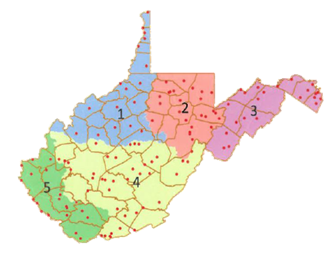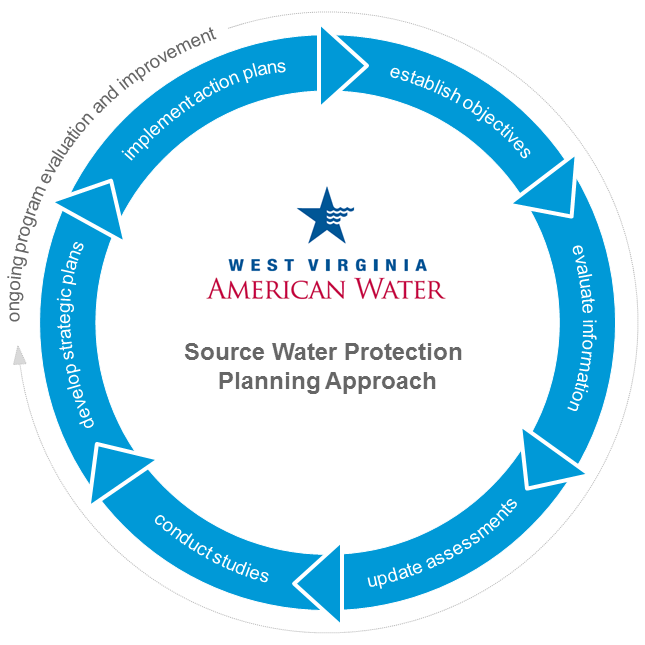SOURCE WATER PROTECTION PLANNING
How to Get Involved
Protecting drinking water at its source is an important part of the process to treat and deliver high quality water. We have developed Source Water Protection Plans to identify and reduce potential risks to drinking water supplies. We update these plans regularly and want YOUR input.
Each West Virginia American Water water system has a unique Source Water Protection Plan. These plans are the cornerstone of an overarching statewide program to protect drinking water supplies. Each plan is updated every three years and staggered by region.
Save the date for YOUR water system’s public meeting or review the plan and submit comments anytime on our website. Below is the West Virginia American Water Source Water Protection Plan update schedule by water system.

- 2024: Region 4: Bluefield, Bluestone, Gassaway, New River, Kanawha Valley, Webster Springs
- 2025: Region 5: Huntington and Region 3: Deerfield Village and Walnut Grove
- 2026: Region 1: Weston
LEARN MORE
Source water protection is an ongoing and evolving program to understand and address risks to drinking water supplies. Each Source Water Protection Plan includes program goals and objectives, regulatory framework, specific plan components, plan implementation, and stakeholder engagement. Each system’s full plan is available for review below.
To learn more about West Virginia American Water’s source water protection planning efforts and provide input, visit our interactive GIS Storymap. Protecting the Source: Your Water, Our Plan (arcgis.com)
ONLINE
Comments related to our Source Water Protection Plans may be submitted online anytime using our online feedback/request form. All submissions will be directed to your local Source Water Protection Manager.
LUNCH & LEARN WEBINAR
We will host a public meeting for each of our operating areas according to the regional update schedule. The information presented at this webinar will be specific to the Bluefield, Bluestone, Gassaway, New River, Kanawha Valley water systems. If you wish to attend, join us virtually using the link below. Participants will have the opportunity to ask questions and submit written comments at the webinar.
Bluefield, Bluestone, Gassaway, New River and Kanawha Valley Water Systems
- Thursday, November 7, 2024
12:00 PM to 1:00 PM
Join Zoom Meeting
https://us02web.zoom.us/j/82908513199?pwd=FQTJyfOEVk0VUc5ibC6W3a0Th4pJSz.1
Meeting ID: 829 0851 3199
+19292056099,,82908513199#,,,,*76102483# US (New York)
+13017158592,,82908513199#,,,,*76102483# US (Washington DC)
CAN’T MAKE IT?
Visit our website to review the plan and submit comments online anytime. Comments must be received by November 22, 2024, to be considered for the 2024 source water protection plan updates.
COMMENTS
The public comment period specific to the 2024 Source Water Protection Plan updates will be open until November 22,2024. Comments may be submitted through the online feedback form, during the webinar, or in writing addressed to:
West Virginia American Water
Attention: Source Water Protection Manager
1600 Pennsylvania Avenue Charleston, WV 25302
Source Water Protection Plan Updates - Approved by WVDHHR
West Virginia American Water submitted an updated Source Water Protection Plan (SWPP) for each of our water systems to the West Virginia Department of Health and Human Resources (WVDHHR) for review in accordance with state regulations. WVDHHR approved each of our submitted SWPPs. Links to the public version of each plan are provided below.
Approved Bluefield Source Water Protection Plan Update
Approved Bluestone Source Water Protection Plan Update
Approved Gassaway Source Water Protection Plan Update
Approved Huntington Source Water Protection Plan Update
Approved Kanawha Valley Source Water Protection Plan Update
Approved New River Source Water Protection Plan Update
Approved Weston Source Water Protection Plan Update
We will continue to accept comments on an ongoing basis for future source water protection plan updates. You may provide input online through our online feedback form or by mail to West Virginia American Water, Attention: Source Water Protection Program Manager, 1600 Pennsylvania Avenue, Charleston, WV 25302.
REGULATORY FRAMEWORK
The basic foundation for source water protection was established on a national level through the Safe Drinking Water Act Amendments passed in 1986 and 1996. These amendments created wellhead protection and source water assessment programs and left responsibility for implementing these programs with each state.
In 2014, the West Virginia Legislature passed Senate Bill 373, which established regulatory requirements for source water protection planning. This added specific requirements for public water utilities to develop and update source water protection plans. A complete copy of Senate Bill 373 can be found here.
The West Virginia Legislature also included provisions through Senate Bill 373 and subsequent Senate Bill 423 to help ensure that contaminants are appropriately stored, handled and safeguarded from ever reaching public water sources. These regulations require that information about contaminant sources be provided directly to water utilities for use in source water protection planning and event response. For more information about aboveground storage tank (AST) notifications to water systems, click here.
PLANNING PROCESS

Our strategic approach to source water protection planning for each of our water systems across the state is an ongoing process that includes the following components:
- Establish vision and program objectives
- Evaluate existing plans and operations
- Update source water assessments
- Conduct technical and feasibility studies
- Develop management strategies and action plans
- Implement strategies and action plans
- Ongoing program evaluation and improvement
Stakeholder involvement is an important part of the planning process. The nature and degree of involvement varies by task and stakeholder group. A few examples include:
- Regulatory agency input on assessment and feasibility studies;
- Emergency responder involvement in contingency planning; and
- Community feedback and support for strategies to address source water issues.
